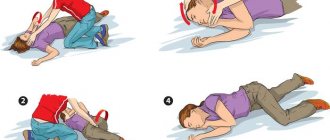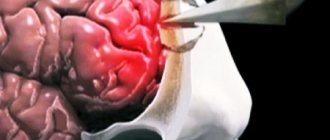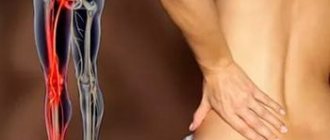A brain contusion can occur when falling from a great height, due to a strong blow, or during an accident. The condition also varies in severity of consequences.
Mild brain contusions
They are not accompanied by a threat to life and manifest themselves with the following symptoms:
- loss of consciousness, lethargy, drowsiness, memory loss;
- dizziness, vomiting;
- changes in heart function, increased blood pressure;
- neurological disorders (tremor of the eyeballs, lack of pupillary response to light, decreased muscle tone, anisocoria);
- meningeal symptoms (neck muscle tension, Brudzinski and Kernig symptoms).
There are no serious consequences for mild brain contusions. The prognosis for the patient is favorable. Symptoms disappear within 3 weeks.
Main services of Dr. Zavalishin’s clinic:
- consultation with a neurosurgeon
- treatment of spinal hernia
- brain surgery
- spine surgery
Head injury causes, symptoms, treatment and prevention methods
The clinical picture is divided into 3 types:
- cerebral, implies the brain’s response to damage;
- local, depends on the area of damage, the greatest danger is from injuries that affect the medulla oblongata;
- meningeal, characterized by irritation of the membranes of the affected organ.
General cerebral symptoms occur with any type of injury:
- feeling of nausea, possible vomiting;
- painful sensations in the brain area;
- attacks of dizziness;
- poor concentration;
- weakened memory.
Meningeal symptoms indicate a brain contusion and involve intense pain, muscle tension in the neck and back, and vomiting, which is not accompanied by relief.
Local symptoms allow you to determine the area where the blow fell. If the occipital part is damaged, the functioning of the visual apparatus is disrupted. This is explained by the location of the nerve pathway from the eyeballs. Patients complain of blindness and double vision.
Symptoms of brain contusion
The bruise is classified into degrees, depending on the severity of the injury. The lung is characterized by the following symptoms:
- fainting for no more than 10 minutes;
- rapid recovery of the body without medical intervention;
- involuntary movements of the eyeballs;
- decreased sensitivity on the opposite side of the body;
- gradual disappearance of symptoms, absence of complications. In mild cases, the clinical picture completely disappears within 3 weeks.
A moderate bruise is accompanied by the following disorders:
- fainting lasting up to 4 hours;
- dullness of consciousness throughout the day;
- pronounced cerebral symptoms;
- meningeal syndrome;
- disruption of the speech apparatus;
- inability to control the movements of the right or left limbs;
- rapid breathing.
Severe degrees are fatal and are accompanied by the following symptoms:
- dullness of consciousness for several days;
- disturbances in the functioning of the cardiovascular system;
- respiratory dysfunction;
- loss of memories of events that preceded the injury;
- disruption of the visual apparatus;
- constant feeling of anxiety;
- mental excitability.
Symptoms of soft tissue contusion of the head
Injury to soft tissues without brain damage is not very dangerous. This is a common injury. The main symptom is the presence of swelling on the head after a blow. When you palpate it, painful sensations appear. Severe soft tissue bruise is accompanied by redness of the skin, clouding of consciousness, bleeding from the nasal cavity, vomiting, constant fatigue, and increased local temperature.
Moderate brain contusions
This injury usually involves a fracture of the skull bones and is accompanied by subarachnoid hemorrhage. She shows herself:
- loss of consciousness for 1–3 hours, psychomotor agitation;
- amnesia;
- severe dizziness;
- nausea;
- vomiting;
- intense headaches;
- high blood pressure, rapid heartbeat;
- increased body temperature;
- meningeal symptoms;
- severe focal neurological symptoms (changes in muscle tone, paresis, loss of sensation in the limbs, epileptic seizures, speech impairment, etc.).
Signs of moderate brain contusions persist from several weeks to 2 months. The consequence of this condition may be irreversible changes that occurred during the injury.
Types of traumatic brain injuries
Doctors divide all traumatic brain injuries into 2 large groups:
- open injuries are the most serious type of injury, in which not only the skull is damaged, but also the soft structures of the brain;
- closed injuries - a brain contusion or a fracture of the skull bones is likely, but the integrity of the soft tissues is not compromised.
Open head injuries include:
- fracture of the base and vault of the skull with soft tissue injuries;
- fracture of the base of the skull with injury to blood vessels.
1 MRI of the brain
2 Treatment of traumatic brain injuries
3 Treatment of traumatic brain injuries
Closed view of TBI
This type of injury is diagnosed in 70% of cases and includes:
- brain concussion;
- brain contusion without compression;
- brain contusion with compression.
Types of traumatic brain injuries by severity:
- mild degree (concussions and some types of brain contusions in which consciousness remains clear);
- moderate degree (brain contusions, characterized by short-term loss of consciousness and the appearance of some neurological abnormalities);
- severe degree (concussion with numerous injuries and compression of the brain, leading to prolonged loss of consciousness, disruption of vital systems and even death).
The consequences of traumatic brain injuries depend on the severity of the specific injury. A mild head injury may not cause any complications, while a moderate head injury may cause neurological impairment, and a severe head injury may result in death.
In all cases of head injury, it is necessary to urgently transport the victim to the nearest hospital or emergency room, where he will receive the necessary diagnostics and qualified treatment for a traumatic brain injury!
Treatment of traumatic brain injuries
Therapy for such injuries is carried out in a hospital setting with mandatory bed rest (from several days to a month).
Treatment of traumatic brain injuries is mainly conservative and symptomatic. Drugs are used to relieve cerebral edema, suppress the gag reflex, painkillers, as well as antihistamines and cardiovascular drugs.
Treatment of traumatic brain injuries when a hematoma and signs of compression of the brain are detected allows for surgical intervention.
1 MRI of the brain
2 MRI of the brain
3 MRI of the brain
Severe brain contusions
Such an injury poses a threat to human life. The consequences of a severe brain injury are serious, and recovery takes several months. Often the victim never fully recovers.
The following signs indicate a severe brain injury:
- loss of consciousness, after which the person is in stupor or a state of stupor;
- temperature rise to 41°C;
- psychomotor agitation, convulsive syndrome;
- disturbances in the respiratory and circulatory system (up to the need for artificial ventilation);
- neurological symptoms (dilation or constriction of pupils, “floating” eyeballs, difficulty swallowing, paralysis, loss of speech);
- pronounced meningeal signs.
Severe brain effects regress extremely slowly. Recovery takes a long time. In some cases, the patient becomes disabled.
The most common consequences of brain contusions are:
- inflammation of the meninges;
- epilepsy;
- atrophy (decrease in tissue volume) of the brain;
- hydrocephalus accompanied by intracranial hypertension;
- scars on the meninges and tissues;
- cerebrospinal fluid cysts;
- post-traumatic porencephaly;
- liquorrhea (due to a skull fracture).
These conditions are accompanied by movement disorders, dizziness, impaired coordination, speech, mental disorders, headaches, decreased intelligence, and convulsive seizures.
First aid for traumatic brain and spinal injuries
Traumatic brain injuries and traumatic injuries of the spinal column not only occupy one of the leading positions among the consequences of road traffic accidents, accidents, falls from heights, extreme sports, criminal cases and domestic incidents, but are also considered the most severe and dangerous to health .
All injuries are usually divided into open, in which the integrity of the skin is damaged, and closed, without visible damage to the soft tissues.
Traumatic brain injuries
The human brain is protected by fairly strong skull bones, but at the same time they can cause severe damage. Traumatic brain injuries include mechanical damage to the head, bone structures and soft tissues (skin, blood vessels, nerve endings, meninges or medulla).
When you hit your head, even without open injuries, the brain also gets bruised by hitting the skull, which doctors call a concussion. As a rule, it is accompanied by dizziness, headache, pallor of the scalp, vomiting, sometimes loss of consciousness, cold sweat, and temporary memory loss. Open head injuries are combined with damage to the integrity of the skin, skull fractures, and bleeding and/or cerebrospinal fluid from the nose and ears. Sunken orbital sockets and subcutaneous hemorrhages in the periorbital area may develop.
In addition, it should be remembered that all of the above symptoms may not appear immediately after the incident, but several hours or even days later. Therefore, even with a minor head injury, it is advisable to contact a traumatologist and conduct the necessary examinations to rule out a concussion or bruises.
Vertebral and spinal injuries
This category includes injuries to the back: soft tissues, muscle structures, the spinal column, tendons, ligaments, blood vessels and nerve fibers intertwining the spine, the spinal cord itself. It should be remembered that a fracture of the cervical or upper thoracic vertebrae can lead to immediate death.
Closed injuries, concussions or compression of the spinal cord can be caused by compression of the brain by dislocations, subluxations or fractures of the vertebral bodies, displaced intervertebral discs, hernias, hematomas, inflamed tissues, etc. Accompanied by complete or partial dysfunction of internal organs, loss of sensitivity, impaired reflex reactions, paresis or paralysis of parts of the body located below the site of injury. Severe injuries are fraught with abscesses, hemorrhages of the spinal cord, necrosis of nerve cells and brain matter.
Open injuries of the spinal column with damage or rupture of the spinal cord are accompanied by spinal shock, loss of motor and sensory capabilities, autonomic functions, disturbances or cessation of the functioning of internal organs. In addition, there may be a significant decrease in temperature, blood pressure, and circulatory disorders. Recovery lasts from several weeks to several years.
First aid for head injuries
- They check whether the victim has a pulse, is breathing, and is conscious.
- An ambulance is called.
- If the victim is conscious and does not experience nausea, he must be laid on his back with a fairly hard cushion under his head (no more than 15° from the horizontal surface).
- The victim should not be given anything to drink, much less eat. This may cause severe vomiting.
- If the victim feels sick and vomits, he is laid on his side and a small cushion is also placed under his head.
- If there are no visible serious damage to the skin and skull, then cold is applied to the site of the injury. This will help relieve the pain a little and reduce the hematoma.
- For a bleeding head wound, apply a sterile bandage. The victim is not allowed to sit up and move independently and is transported to the hospital in a supine position.
First aid for back injuries
Signs of spinal injury:
- sharp pain in the neck or back;
- weakness in the lower or upper extremities;
- lack of motor abilities (paralysis of the body below the affected area);
- loss of sensitivity of the skin below the affected area;
- dysfunction of internal organs (for example, urinary or fecal incontinence).
Actions:
- They check whether the victim has a pulse, is breathing, and is conscious. Under no circumstances should you attempt to shift, turn over, or lift a person on your own. This can dislodge damaged vertebrae and cause even more harm to the body.
- The position of the victim is fixed, not allowing him to move, much less stand up. They try to stop visible bleeding, then wrap them up to prevent hypothermia, constantly monitoring breathing and pulse.
- If the victim is conscious and feels well, you can try to place him on a hard, flat surface with additional support for the head and entire body. This will require the help of several people who will synchronously perform the movement, holding the victim by the head, shoulders, pelvis and legs.
- Some cases require placing the victim on his stomach, but this action is performed only by the ambulance team.
- It is not recommended to give the victim anything to drink or eat until a full examination of the body has been carried out.
Author: K.M.N., Academician of the Russian Academy of Medical Sciences M.A. Bobyr










